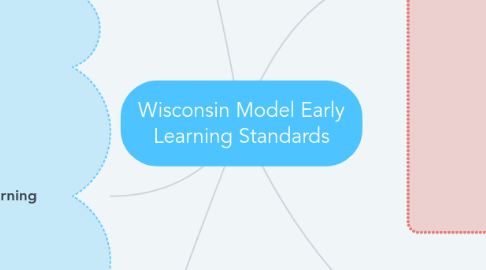
1. Language Development and Communication
1.1. Listening and Understanding
1.1.1. Derives meaning through listening to communications of others and sounds in the environment
1.1.2. Listens and responds to communication with others
1.1.3. Follows directions of increasing complexity
1.2. Speaking and Communicating
1.2.1. Uses gestures and movements (non-verbal) to communicate
1.2.2. Uses vocalizations and spoken language to communicate Language Forms (Syntax: rule system for combining words, phrases, and sentences, includes part of speech, word order, and sentence structure)
1.2.3. Uses vocalizations and spoken language to communicate. Language Content (Semantics: rule system for establishing meaning of words, individually and in combination)
1.2.4. Uses vocalization and spoken language to communicate. Language Content (Pragmatics: rules governing the use of language in context)
1.3. Early Literacy
1.3.1. Develops ability to detect, manipulate, or analyze the auditory parts of spoken language
1.3.2. Understands concept that the alphabet represents the sounds of spoken language and the letters of written language
1.3.3. Shows appreciation of books and understands how print works
1.3.4. Uses writing to represent thoughts of ideas
2. Approaches to Learning
2.1. Curiosity, Engagement, and Persistence
2.1.1. Displays curiosity, risk-tasking, and willingness to engage in new experiences
2.1.2. Engages in meaningful learning through attempting, repeating, experimenting, refining, and elaborating on experiences and activities
2.1.3. Exhibits persistence and flexibility
2.2. Creativity and Imagination
2.2.1. Engages in imaginative play and inventive thinking through interactions with people, material, and the environment
2.2.2. Expresses self creatively through music, movement, and art
2.3. Diversity in Learning
2.3.1. Experiences a variety of routines, practices, and languages
2.3.2. Learns within the context of his/her/ family and culture
2.3.3. Uses various styles of learning including verbal/linguistic, bodily/kinesthetic, visual/spatial, interpersonal, and intrapersonal
3. Cognition and General Knowledge
3.1. Exploration, Discovery, and Problem Solving
3.1.1. Uses multi-sensory abilities to process information
3.1.2. Understands new meanings as memory increases
3.1.3. Applies problem solving skills
3.2. Mathematical Thinking
3.2.1. Demonstrates an understanding of numbers and counting
3.2.2. Understands number operations and relationships
3.2.3. Explores, recognizes, and describes, shapes and spatial relationships
3.2.4. Uses the attributes of objects for comparison and patterning
3.2.5. Understands the concept of measurement
3.2.6. Collects, describes, and records information using all senses
3.3. Scientific Thinking
3.3.1. Uses observation to gather information
3.3.2. Uses tools to gather information, compare observed objects, and seek answers to questions through active investigation
3.3.3. Hypothesizes and makes predictions
3.3.4. Forms explanations based on trial and error, observations, and explorations
4. Social and Emotional Development
4.1. Emotional Development
4.1.1. Expresses a wide range of emotions
4.1.2. Understands and responds to others' emotions
4.2. Self-concept
4.2.1. Develops positive self-esteem
4.2.2. Demonstrates self-awareness
4.3. Social Competence
4.3.1. Demonstrates attachment, trust, and autonomy
4.3.2. Engages in social interaction and plays with others
4.3.3. Demonstrates understanding of rules and social expectations
4.3.4. Engages in social problem solving behavior and learns to resolve conflict
5. Health and Physical Development
5.1. Physical Health and Development
5.1.1. Demonstrates behaviors to meet self-help and physical needs (sleep)
5.1.2. Demonstrates behaviors to meet self-help and physical needs (dressing)
5.1.3. Demonstrates behaviors to meet self-help and physical needs (toileting)
5.1.4. Demonstrates behaviors to meet self-help and physical needs (eating)
5.1.5. Demonstrates behaviors to meet safety needs
5.1.6. Demonstrates a healthy life style
5.2. Motor Development
5.2.1. Moves with strength, control, balance, coordination, locomotion, and endurance (purpose and coordination)
5.2.2. Moves with strength, control, balance, coordination, locomotion, and endurance (balance and strength)
5.2.3. Exhibits eye-hand coordination, strength, control, and object manipulation
5.3. Sensory Organization
5.3.1. Uses senses to take in, experience, integrate, and regulate responses to the environment
